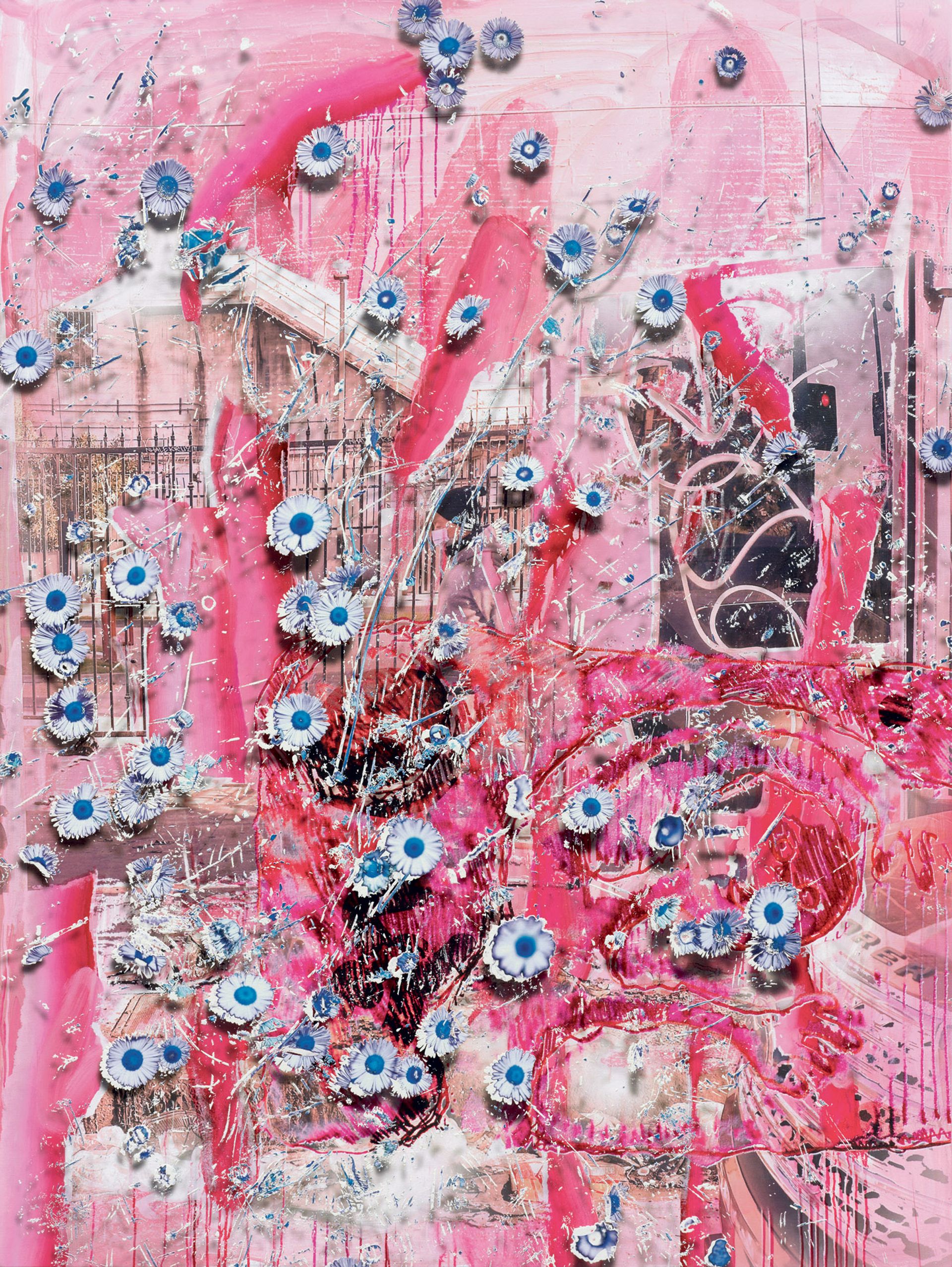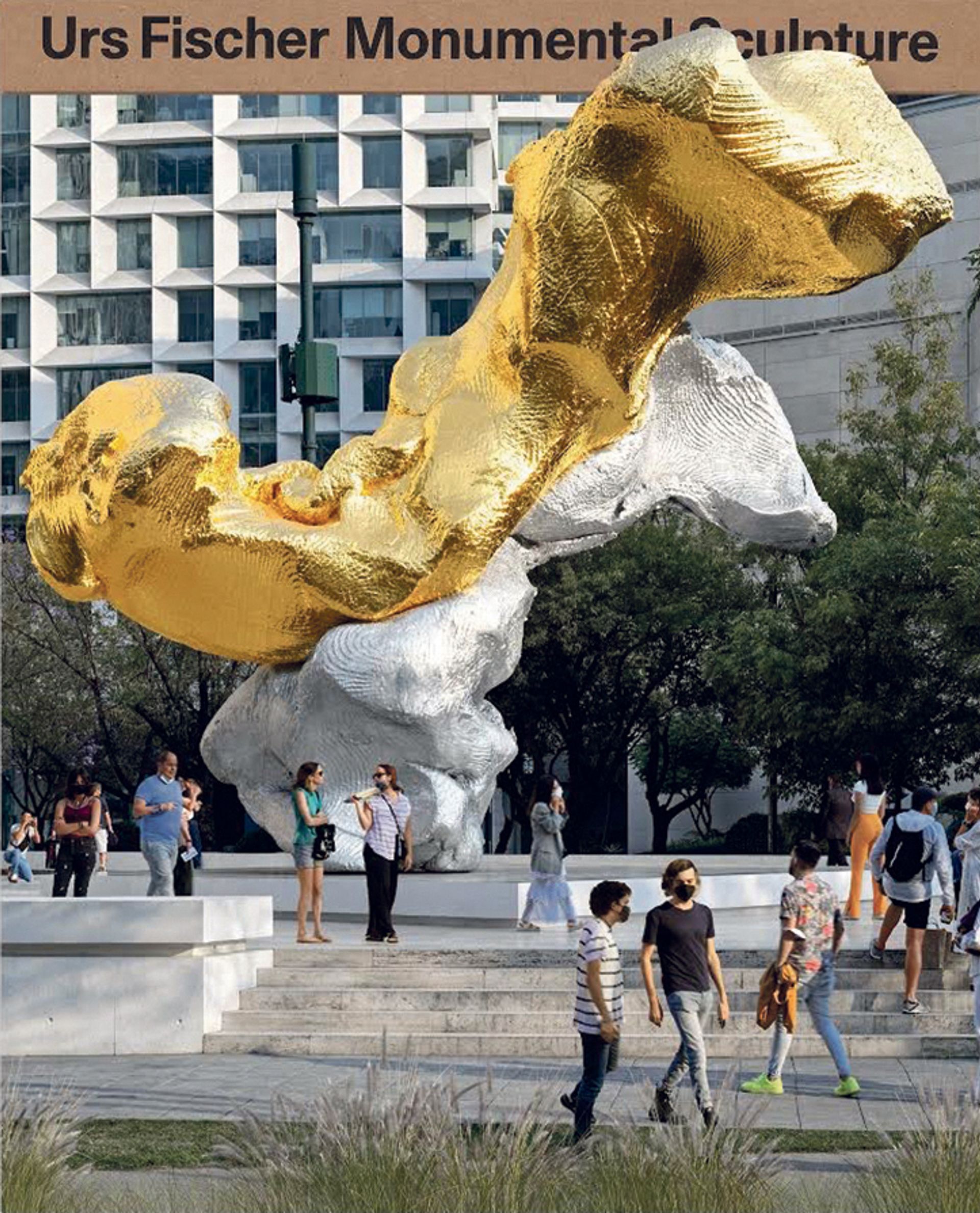With a new book, Monumental Sculpture, being launched at the Art Basel Shop, Urs Fischer is returning home to Switzerland with ever more grandiose ambitions. The maverick artist—who has made outlandish sculptures of everything from giant cigarette packets merged with school chairs, immense yellow teddy bears bludgeoned by lamps, and entire villages comprised of bread buildings—never makes one thing at a time. He is always fusing one thing with another, scaling it up, and making it weird.

Urs Fischer’s Blue Flowers (2024) at Gagosian’s stand at Art Basel Photo: © Urs Fischer, courtesy the artist and Gagosian
It is true that publishing a book is less risky than shipping one of his monumental sculptures to Basel; the curator Massimiliano Gioni once said that Fischer was so behind schedule finishing a huge cast-aluminium sculpture in China that “sending it by air [to his exhibition was] going to cost $40,000… I’m not surprised, but I am pissed off”. Monumental Sculpture is not just a route to playing safe, though, as there is a wild ride of an introductory essay by Róisín Tapponi, perhaps the trendiest art writer of the day, and a fascinating interview with the long-time Fischer scholar Jessica Morgan, as well as an impressive carousel of Fischer’s greatest hits.
The Art Newspaper: Your most recent exhibition, Beauty, was on show at Gagosian in Paris this spring, and featured several works as part of the Problem Paintings series. What does beauty mean to you?
Urs Fischer: It means many things. If you think of a flower, there is a beauty because nature is inherently beautiful to us. If you see a bird, with all its plumage, who performs a seductive display with its feathers during hot summer, that takes place to seem beautiful and desirable to other birds. Insects are drawn to colours. I have a garden now, in Los Angeles, and I think of the wild and joyous history of blossoms and spend a lot of time looking at all the plants and flowers blooming. I think our sense of beauty is always linked to nature; however you are constructed it’s a nature thing, often an animal thing. In terms of the materials we used in the Beauty show, we now make silkscreens on a huge press; before, we were always crawling about on the floor, peeling the panels back on flat surfaces. But it’s all about the organic subjects, even when we think about the beauty industry: we look at how somebody looks, we look how someone feels, how someone thinks. It’s all nature. It’s part of who we are.
In an essay in Monumental Sculpture, the writer Róisín Tapponi talks a lot about these works as fearless. She says that “it is impossible to be afraid if you can make something as big and tall as these monumental sculptures… Maybe I’m wrong, but Fischer doesn’t seem like someone who feels fear much.” Do you agree? Do you see yourself as a fearless artist, or as a fearless person?
I’m a parent, so logically I have a lot of fear about lots of things. Of course, I fear death because I am a human being. How can that not be inevitable? But I don’t fear anything when I make my large sculptures, no. I come from a background which has always been more autodidactic anyway, and perhaps that is inclined towards taking risks. When you create work as an artist, you want to do two things: to communicate something and to belong to something. One of my favourite ideas is to imagine somebody looking at one of my artworks: they don’t know me, perhaps they don’t care about me, and we will never meet. But if they have an experience or reaction—something changes in them—when they see my work, then I want to belong to that, even if I’ll never know about it. That’s always been my desire as an artist.
You make all of your Big Clay sculptures in a foundry in China. Is that because of scale, and of being able to make something bigger there? Are you able to be more ambitious in China? Or perhaps more anonymous?
Some time ago, I did one of the Big Clay sculptures at a foundry in Switzerland and we realised it was impossible; it costs us more than whatever we could sell them for. We wouldn’t be able to find a buyer. So, I had this one guy scour foundries in Eastern Europe, China and the Middle East, and we settled on this joint venture with a foundry in Pudong. They brought their expertise, knowledge and precision, and we were able to do something special. We soon learned that they have no fear of tackling a big thing. I don’t know why.
The Big Clays look like something you could make in your hand, scaled up. Do you see them like this, or have you always pictured them as monumental sculptures of high-rise proportions?
Well, there are so many digital ways now to scale things up, but it’s not too dissimilar from Renaissance sculptors who scaled up using terracotta. Everything begins with the maquette. You can retain more detail, and there’s less interpretation for the artist. But I try not to make distinctions when thinking about size or scale. It’s all about the gesture. When I’m making these sculptures, I feel like a guitarist onstage in a 100,000-capacity stadium, because the logic is the same: do you need the guitar to be proportionally related to the stadium just because it’s a huge venue? Or can the intimate gesture of plucking a string fill that space? In art, you can have an intimate gesture assume a grandness of scale so long as you recognise that it’s still ephemeral and immaterial.

Monumental Sculpture explores the artist’s works and features essays by writers including Jessica Morgan and Róisín Tapponi © Urs Fischer, courtesy Gagosian
Do you see your monumental sculptures as very site-specific and responsive to the place in which they are displayed?
First of all, it’s important to remember that some sculptures are made by subtracting, and others by adding. For instance, if you look at a marble sculpture or a wood carving, there is a different kind of presence; these are subtractive sculptures, because you must reduce and mould the surface. When you make with clay—for instance, my Big Clay series, such as the one outside the Museum of Contemporary Art in Los Angeles—it’s all additive. It’s this process that I use to make the work specific to a place. There is a softness to it. This act of creation reminds me of when my daughter was a baby and I gave her my finger: right away she holds on. She grasps, she needs to hold on. [Fischer makes a “vurum!” sound]. My site-specific sculptures work in this way. If you see The Whale (2018-21) at the Four Seasons in Lāna‘i, Hawaii, it’s made with the knowledge that it’s set against the Pacific. It’s all about the small gesture and the sheer power, like the power of the Pacific arc wheeling down from Alaska to Chile. It’s the small gesture and the awesome power. That’s the kind of art that I want to make. Now, I must go. I need to collect my daughter from school.
• Urs Fischer: Monumental Sculpture, Priya Bhatnagar, Urs Fischer, Jessica Morgan and Róisín Tapponi (contributors), Gagosian, 396pp, $150 (pb)
• For an in-depth interview with Urs Fischer on his cultural experiences and greatest influences, from jazz and drawing workshops to Hieronymus Bosch, listen to this episode of our A Brush With... podcast


